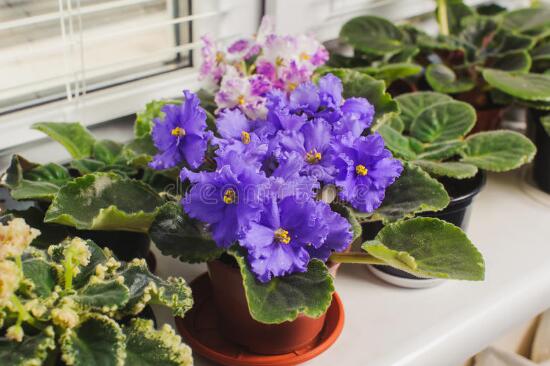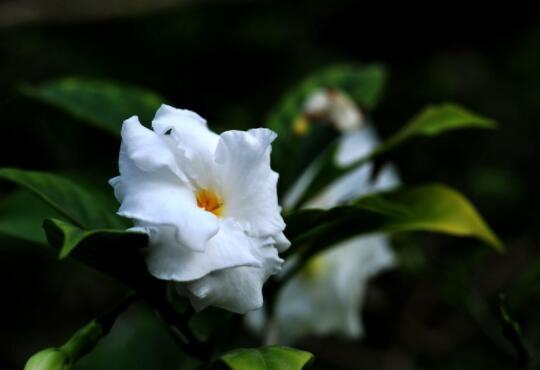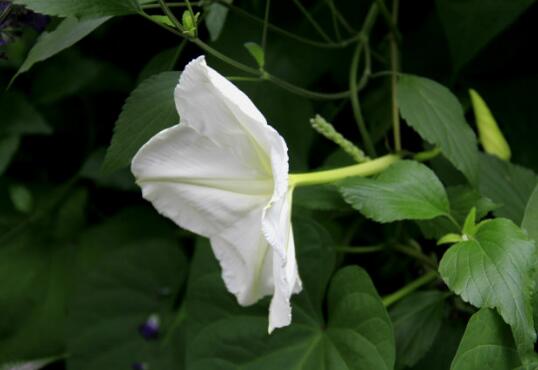What is the reason for the yellowing of the leaves of Corydalis, insufficient light / too much watering / improper fertilization
Keeping a pot of African pansy indoors is the choice of many flower friends. It has emerald green leaves, bright colors and excellent ornamental properties. But in the process of breeding, due to various reasons, many flower friends of Corydalis will appear the phenomenon of leaf yellow, seriously affecting the ornamental of the plant. So, what is the reason why the leaves of African pansy turn yellow? Today, the editor is here to solve this problem for everyone.
I. what is the reason for the yellowing of the leaves of Corydalis?

The yellowing of the leaves of Corydalis is actually caused by four reasons: great changes in the environment, plants can not adapt to the leaves will be yellow; lack of light, lack of photosynthesis and yellowing of leaves; too much watering affects root absorption, leaves will also turn yellowing; insufficient or excessive fertilization will also cause leaves to yellowing.
Second, the solution to the yellowing of the leaves of Corydalis.
1. Lack of light
There is no lack of light in plants. Although African pansy is more shade-tolerant, its lack of light can also cause problems. Once the African pansy is kept in the dark for a long time, its leaves will turn yellow due to lack of photosynthesis, and sometimes the leaves of the African pansy will grow wildly.
The solution: it is simple to add light to the African pansy, but the African pansy is afraid of strong light, so in daily maintenance, except for the strong light in summer, the African pansy should receive sufficient light in all seasons.
2. Overwatering
African pansy likes a humid environment, and we should water it more during its growing season. But for beginners, watering is difficult to control, they often have too much watering, too often, resulting in stagnant water in the basin. And the root system soaked in the water for a long time, breathing will not be smooth, leaves can not absorb nutrients, will naturally turn yellow.
Solution: when the soil is found to be too wet, loosen the soil, and move the African pansy to a ventilated sunny place to allow the water to evaporate quickly; if the soil is too wet for a long time, it is easy to soak the roots, then you should remove the plant and cut off the rotten roots. then replace it with new soil and replant it.
3. Improper fertilization
After watering, let's talk about fertilization, which is also one of the reasons for the yellowing of the leaves of Corydalis. On the other hand, fertilization is applied too little or too much, as follows:
Insufficient fertilization in ①: African pansy likes to be fat, and sufficient nutrients can make it blossom more beautifully. Once insufficient fertilization, not only affect its flowering, its leaves will also be yellowed due to lack of nutrients. Solution: it's simple, we just need to replenish the fertilizer in time to make it recover slowly.
Too much fertilizer for ②: when applying fertilizer to Corydalis, it should be applied frequently and thinly, otherwise if the fertilizer is too much or too thick, it is easy to burn the root system and lead to the emergence of yellow leaves. Solution: pour water into the flowerpot in time to dilute the fertilizer and let it flow out from the bottom of the pot; if it is not found in time, the root system is burnt out, we need to cut off the rotten root and change the pot soil to replant it.
4. Environmental discomfort
If the above reasons for improper maintenance can be ruled out, then the yellowing of African pansy leaves may be caused by environmental discomfort. In a hot and dry environment, or in an environment with poor ventilation, the leaves are easy to turn yellow. in addition, potted plants bought online will appear yellow leaves because of large geographical cross-service and great changes in the environment.
Solution: keep the African pansy in a ventilated semi-shade; when the newly bought potted leaves turn yellow, you should provide the most suitable environment for its growth according to its growth habits, and soon the plant will return to health.
Generally speaking, the breeding method of African pansy is not difficult, but it does not mean that it can be raised casually. If its leaves are evergreen and do not turn yellow, we must pay attention to the light, water and fertilizer. Of course, don't worry when you find yellow leaves, just solve it according to the above method. With regard to the yellowing of the leaves of African pansy, the editor has introduced this, hoping to bring help to you.
How to raise African pansy? Culture methods and matters needing attention of African Corydalis
African Corydalis, also known as S ã o Paulo, African Violet, etc., is a perennial evergreen herb of the genus Viola of Gesneriaceae. The flowers of African pansy are small, colorful, poetic and of high ornamental value. Corydalis is a famous potted flower in the world, which is often planted indoors. So, how to raise African pansy? The breeding methods and matters needing attention of African pansy are introduced as follows.
Picture: African pansy
I. Culture methods of African pansy
1. Flowerpot selection: African pansy plant short, root distribution is not wide, flowerpot is too large to hinder elegance; too small and affect development, so it is necessary to choose a small flowerpot commensurate with the plant size.
two。 Soil: the basin soil can be mixed with 5 parts of rotten leaf soil, 3 parts of garden soil, 2 parts of compost soil, or 6 parts of rotten leaf soil and 4 parts of Gaza soil, and can also be mixed with rotten leaf soil, peat soil and sandy soil.
3. Temperature: the suitable temperature for the growth of Corydalis is 18-24 ℃, and the growth is poor when the air temperature is above 27 ℃, and shading and cooling measures must be taken in midsummer; when the air temperature drops below 16 ℃, the growth stops and can tolerate the low temperature of 7-10 ℃ for a short time, so the room temperature in winter should not be lower than 12 ℃.
4. Lighting: African Viola shade-tolerant plants should not be placed in places where the sun is too strong or too shady. In addition to more sunlight can be seen indoors in winter, it is appropriate to keep it in a place with scattered light in other seasons, especially in summer, preferably in a cool and ventilated place indoors.
5. Moisture: water can not be too much, basin soil is too wet easy to rot roots. Watering should grasp the principle of seeing dry and wet, watering should be sufficient in summer, and it is appropriate to wait until the basin soil is slightly dry in other seasons. When watering, the leaves should be gently irrigated from the edge of the basin, or use the soaking basin method to replenish water, must not be sprinkled at the head, otherwise it is easy to cause leaf decay.
6. Fertilization: the rarefied mature liquid fertilizer or compound flower fertilizer combined with nitrogen and phosphorus should be applied about 10 days during the growth period, but we should pay attention to the application of nitrogen fertilizer not too much, otherwise the leaves grow luxuriantly but bloom rarely. Therefore, the ratio of nitrogen, phosphorus and potassium fertilizer should be 1 ∶ 1 ∶ 1. After the emergence of buds, adding 0.5% superphosphate 1-2 times will result in bright flowers, and gently lift the leaves when fertilizing, so as not to make the fertilizer and water stick on the leaves, so as to prevent the leaves from blotting and decay.
Picture: African pansy
II. Matters needing attention in the culture of African pansy
1. African pansy likes semi-overcast, warm and humid environment. The suitable temperature for growth is 20-22 ℃, and the suitable light intensity is between 10000-12000lx. Avoid strong light and high temperature in summer, spray shading agent or use shading net on cultivation facilities, cover strong light, and spray water to cool and humidify, but pay attention to good ventilation.
two。 In the process of breeding, the air humidity should be kept high, and the water should be properly watered, but it should not be too wet. On one side, the stems and leaves should rot, and the difference between water temperature and air temperature should be lower than 5 ℃, so as to prevent the leaves from yellowing. The light should be suitable, the lack of light will affect flowering, too strong will cause leaves yellowing and scorching.
3. Usually watering should not be too much, to wait until the basin soil is slightly dry before watering, basin soil stagnant water is often the main cause of plant decay. During the growing period, the mature thin liquid fertilizer or compound chemical fertilizer is applied every 7 to 10 days, the content of nitrogen fertilizer in the fertilizer should not be too much, otherwise the leaves will grow luxuriantly and bloom very little.
[editor's conclusion] African pansy likes a warm and humid environment and is afraid of bright light and high temperature in summer, so it needs special attention in the process of maintenance. The above introduces the breeding methods and matters needing attention of African pansy, hoping to be helpful to you!
How to raise African pansy? Saintpaulia ionantha, also known as African Violet (scientific name: African Violet), is a perennial herb of the genus Gesneriaceae. Stemless, whole plant hairy. Leaves ovate, petiole stout and fleshy. One or more flowers together, lavender. There are many varieties, such as large flowers, single, semidouble, double, variegated leaves, etc., with purplish red, white, blue, pink and double colors. This article mainly introduces the maintenance methods of African pansy, hoping to be helpful to the flower friends who plant African pansy. Temperature and light African pansy likes warm, humid and semi-shady environment, and is afraid of strong light and high temperature in summer. Shade is needed in summer and the leaves are green and green; in winter it is sunny enough to blossom continuously; rain and snow plus auxiliary light is very beneficial to the growth and flowering of African pansy. The growth temperature is 16: 24 ℃, 18: 24 ℃ from April to October and 12: 16 ℃ from October to April of the following year. The daytime temperature is no more than 30 ℃, and the high temperature is disadvantageous to the growth of Corydalis. Flowering: from spring to autumn, it will blossom if there is plenty of light in winter. The night temperature in winter is not lower than 10 ℃, otherwise it is easy to suffer frost injury. Relative humidity of 40% to 70% is more appropriate, the basin is too wet, easy to rot roots. The air is dry and the leaves are lack of luster. 2. In the process of watering cultivation, high air humidity should be maintained and properly watered so as not to get too wet so as to avoid stem and leaf rot. The difference between water temperature and air temperature should be less than 5 ℃, otherwise, a large number of yellow spots will be produced on the leaf surface. If the light is insufficient, it will blossom less and the color will be light, or even only the long leaves will not blossom; if the light is too strong, it will cause the leaves to yellowing and scorching, which can be maintained in a place with bright light and no direct sunlight, and the suitable temperature for growth is 16 ℃ to 24 ℃. Keep it in a cool and ventilated place in summer to avoid hot and humid environment and hot sun exposure. Usually watering should not be too much, to wait until the basin soil is slightly dry before watering, basin soil stagnant water is often the main cause of plant decay. 3. Fertilization during the growing period of Corydalis, a mature thin liquid fertilizer or compound fertilizer is applied every 7 to 10 days, the content of nitrogen fertilizer in the fertilizer should not be too much, otherwise the leaves will grow luxuriantly and blossom very little. Fourth, the flowerpot can be selected with a plastic pot, and the pot size can be determined according to the plant size. it is not good to be too big or too small. If you want to blossom early, you can plant it in a smaller pot. If you want to look beautiful as a whole, you can coat a proper ceramic basin in a plastic basin. The red pottery basin is well breathable, but the watering should keep up, and it is easy to accumulate salt, and it can be soaked and cleaned many times for a long time. Fifth, pest prevention in high-temperature and humid conditions, prone to Fusarium wilt, powdery mildew and leaf rot, 10% antibacterial agent 401acetic acid solution 1000 times can be sprayed or infused into the basin soil. Scale insects and red spiders often harm African violets during the growing period and can be sprayed with 1000 omethoate EC. Sixth, the soil basin soil should be loose and fertile, and the soil rich in humus should be used. It is generally mixed with 5 parts of rotten leaf soil, 3 parts of garden soil, 2 parts of rotten stable fertilizer soil, or 6 parts of rotten leaf soil and 4 parts of Gaza loam. it can also be mixed with rotten leaf soil, peat soil and sandy soil. African violets are small and beautiful potted flowers with long flowering period, many varieties and brilliant colors. They are good indoor flowers and plants. They are good decorations for window sills, living rooms and desktops. This is the end of the introduction of African Violet culture methods. I hope it will be helpful to everyone.
- Prev

How to control the temperature / apply thin fertilizer / replenish water / light when the leaves turn yellow?
Bermudagrass is a kind of flower plant with high ornamental value, which can be seen in all provinces and regions in southern China, but even if the ornamental plant is highly ornamental, its overall beauty will be affected if its leaves turn yellow. what about the yellowing leaves? Next, the editor will take you to learn about it.
- Next

How to reproduce the moonlight flower, the propagation method of the moonlight flower / mainly by seed propagation
Moonflower is a common flower plant in people's life, and it can be seen in many parts of our country. As more and more people breed it everywhere, the problem about its reproduction has also become a point of concern to people. How to reproduce moonlight flowers? What is the breeding method of moonlight flower?
Related
- Fuxing push coffee new agricultural production and marketing class: lack of small-scale processing plants
- Jujube rice field leisure farm deep ploughing Yilan for five years to create a space for organic food and play
- Nongyu Farm-A trial of organic papaya for brave women with advanced technology
- Four points for attention in the prevention and control of diseases and insect pests of edible fungi
- How to add nutrient solution to Edible Fungi
- Is there any good way to control edible fungus mites?
- Open Inoculation Technology of Edible Fungi
- Is there any clever way to use fertilizer for edible fungus in winter?
- What agents are used to kill the pathogens of edible fungi in the mushroom shed?
- Rapid drying of Edible Fungi

